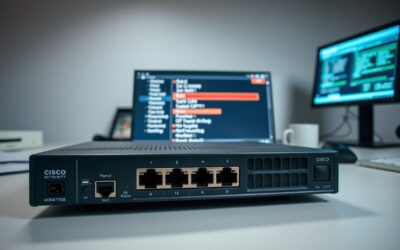Ever spent hours troubleshooting a misconfigured firewall or scrambling to patch a vulnerability? You’re not alone. Modern digital ecosystems demand constant vigilance, but manual processes leave gaps for human error. Here’s the good news: smarter tools now handle repetitive tasks while safeguarding your systems.
Imagine sipping your morning coffee while software scans for configuration flaws or policy mismatches. Brands like Fortinet and Swimlane already use these strategies to detect risks in real time. This isn’t sci-fi—it’s how proactive teams stay ahead of threats like ransomware and phishing attacks.
Through a CCNA lens, we’ll unpack tools like Cisco DNA Center and REST APIs that streamline workflows. You’ll learn how automated protocols reduce downtime and enforce consistency, whether you’re managing devices or encrypting data. Ready to transform overwhelm into confidence? Let’s dive in.
Key Takeaways
- Automated systems minimize human errors in configurations and threat detection.
- Tools like APIs and Cisco DNA Center simplify complex security tasks.
- Real-time monitoring helps identify vulnerabilities before they escalate.
- Leading companies use automation to enforce data protection policies.
- Practical CCNA strategies balance efficiency with robust safeguards.
Understanding Network Automation and Security
Picture your systems running like a well-conducted orchestra, where each instrument plays its part without missing a beat. That’s what happens when repetitive tasks are handled by intelligent tools instead of manual labor. This shift isn’t just about speed—it’s about building a fortress around your digital assets.
What Is Network Automation and How Does It Work?
Think of it as a tireless assistant. Software coordinates devices, applies configurations, and monitors performance—all while you focus on strategic goals. For example, zero-touch provisioning lets devices self-configure upon connection, slashing setup time by 80% in some cases. A retail client once avoided a ransomware attack because automated scripts patched a vulnerability before hackers could exploit it.
Defining Security in Today’s Digital Landscape
Modern protection isn’t a single lock—it’s layers of shields. Firewalls, encryption, and access controls work together like puzzle pieces. Swimlane Turbine, for instance, correlates alerts to spot phishing attempts moving sideways through systems. Research shows 47% of breaches stem from human slips, but platforms like FortiManager cut those errors by 90% through policy consistency.
As demands grow, blending these processes becomes critical. The right mix of speed and safeguards doesn’t just solve today’s headaches—it future-proofs your entire setup.
Identifying the Need for Automated Network Security
Ever felt overwhelmed juggling endless security updates and patch deployments? Manual processes often create gaps where even small oversights can escalate into breaches. A single missed firewall rule or delayed software update might cost your team hours—or worse, expose sensitive data.
How Can Your Organization Benefit from Reduced Human Error?
Manual setups are like tightrope walking without a safety net. Research shows 74% of breaches involve human error, like misconfigured access controls. One healthcare provider avoided a $2M compliance fine by using automated scripts to enforce encryption policies across 500+ devices—errors dropped by 88% in six months.
Modern tools act as your safety harness. They apply patches instantly, flag policy mismatches, and generate audit trails for regulators. For example, platforms like Nile’s systems auto-resolve vulnerabilities 40% faster than manual reviews. Alerts trigger only for genuine threats, letting your team focus on strategic priorities.
Think of it as upgrading from a paper map to GPS navigation. Automated workflows guide configurations, reduce downtime, and lock down sensitive areas. The result? Your team spends less time firefighting and more time building a resilient infrastructure.
Exploring Best Practices in Network Automation
Imagine building a house where every brick aligns perfectly. That’s what happens when you match your tools to your infrastructure’s unique blueprint. Start by auditing your current setup—what repetitive tasks drain your team? Configuration drift? Missed patches? Pinpoint these pain points first.
How to Choose the Right Automation Tools for Your Network?
Think of tool selection like hiring a contractor. Do they understand your floor plan? Look for platforms that integrate with existing devices and scale as you grow. A financial firm reduced firewall errors by 70% using solutions with role-based access controls—like giving specific keys to different crew members.
Prioritize these three features:
- Compatibility with your current systems (no square pegs in round holes)
- Real-time monitoring for configuration consistency
- Built-in security protocols like encrypted APIs
What Are the Steps to Implementing Automation Gradually?
Upgrading your setup shouldn’t feel like demolishing walls. Start small—automate device backups before tackling complex traffic routing. One telecom company saved 5 hours weekly by scripting configuration updates for 100 routers first. Test each script in a sandbox, like rehearsing a play before opening night.
Follow this phased approach:
- Map all devices and processes (know every pipe and wire)
- Begin with low-risk tasks like log analysis
- Expand to policy enforcement after successful trials
Remember, automation isn’t set-and-forget. Schedule regular updates to keep defenses sharp—like changing locks when new keys circulate. Teams that iterate gradually see 60% fewer rollout errors compared to big-bang approaches.
Techniques and Tools in Modern Network Operations
What if your team could spot a phishing attempt before it reaches inboxes or fix a misconfigured server in seconds? Modern tools turn these scenarios into daily realities. Let’s explore how cutting-edge solutions simplify complex workflows while keeping defenses airtight.

Utilizing SIEM, IDPS, and Configuration Management Tools
Imagine a security team that never sleeps. SIEM platforms like Splunk aggregate logs from firewalls, servers, and apps—flagging anomalies in real time. When OSHEAN adopted Kentik’s observability platform, they reduced incident response time by 35% through automated alert triage.
Intrusion detection systems (IDPS) act like digital bloodhounds. They sniff out suspicious patterns, like repeated login failures or unusual data transfers. One logistics company blocked a ransomware attack because their IDPS spotted encrypted files moving to an unknown IP address at 2 a.m.
Configuration management is your safety net. Tools like Ansible enforce standardized settings across routers and switches—no more “oops” moments from manual typos. Chef automates compliance checks, ensuring devices meet policies 24/7. Research shows teams using these tools resolve configuration drift 50% faster.
Integration is key. Platforms like NetBrain sync with SIEM systems, turning raw data into visual maps. This lets you see if a slow server connects to a recent firewall change. Real-time monitoring isn’t just about catching threats—it’s about optimizing performance before users notice hiccups.
By blending these techniques, you create a self-healing ecosystem. Alerts get prioritized, patches deploy silently, and your coffee stays warm while the platforms handle the heavy lifting.
Network Automation and Security
What if every suspicious login attempt triggered an instant lockdown? Modern platforms analyze patterns faster than any human team. They spot anomalies like unusual data transfers or repeated failed logins—then act before damage spreads.
Turning Alerts Into Action
Imagine your systems neutralizing a phishing attack mid-strike. A financial firm did exactly this when their Cortex XSOAR playbook blocked malicious IPs within 12 seconds of detection. Automated response tools updated firewall rules, quarantined devices, and notified analysts—all without coffee breaks.
Integrated software acts like a hyper-vigilant guard. It cross-references low-priority alerts to uncover hidden risks. For example:
| Manual Process | Automated Solution | Time Saved |
|---|---|---|
| Alert triage by humans | AI-powered correlation | 47 minutes/incident |
| Patch deployment delays | Instant CVE mitigation | 93% faster |
| False positive handling | Context-aware filtering | 68% reduction |
Research shows teams using these detection tools resolve threats 40% faster. One healthcare provider slashed breach risks by 79% after deploying PAN-OS devices that auto-blocked ransomware signatures.
Timely response isn’t just about speed—it’s about precision. Platforms like Cortex XSOAR prioritize genuine threats, letting your crew focus on strategic defenses. Why wait for disaster when your systems can intercept it at the door?
Streamlining Network Management for Enhanced Efficiency
Think about reclaiming hours lost to manual updates. Automated patch management acts like a silent guardian, applying critical fixes while your team sleeps. No more late-night scrambles or missed deadlines—just consistent protection humming in the background.

How Timely Updates Protect Your Systems Effortlessly
Picture a retail chain that slashed patch deployment time by 75% using centralized tools. Their IT crew shifted from firefighting to optimizing customer apps, boosting sales by 14% in one quarter. That’s the power of letting automation handle repetitive tasks.
Here’s why this approach works:
- Consistency: Every device receives updates simultaneously, eliminating configuration gaps.
- Speed: Critical patches deploy within minutes, not days, across your entire setup.
- Visibility: Real-time alerts flag successes or hiccups, so you’re always informed.
Manual methods resemble changing tires on a moving car—risky and inefficient. Modern processes ensure compliance without last-minute audits. One healthcare provider avoided $850k in fines by automating vulnerability scans across 1,200 endpoints.
Your team deserves to focus on growth, not grunt work. With streamlined management, you’ll spend less time clicking “update” and more time building what matters.
Integrating AI and Cybersecurity Trends into Your Network
Imagine your systems predicting threats like a weather radar spots storms. That’s AI in action—analyzing patterns to flag risks before they strike. For instance, machine learning now detects zero-day exploits by spotting unusual data flows, like a bank that blocked 12 phishing attempts daily using email analysis tools.
Leveraging AI to Enhance Protection Workflows
Traditional methods wait for alarms. AI acts like a smoke detector that also finds matches before they’re lit. Swimlane’s Cortex XSOAR, for example, auto-quarantines devices showing odd login behaviors—freeing your team to tackle complex issues. Studies show these platforms reduce false alerts by 62%, letting analysts focus on genuine risks.
Using Predictive Analytics to Anticipate Threats
Think of it as a crystal ball for your infrastructure. By studying past attacks and global trends, AI forecasts vulnerabilities. One retailer avoided a $3M breach when predictive models flagged an unpatched server as high-risk—weeks before hackers targeted it.
| Traditional Approach | AI-Driven Strategy | Outcome |
|---|---|---|
| Manual log reviews | Behavioral anomaly detection | 89% faster threat ID |
| Monthly vulnerability scans | Real-time risk scoring | 75% fewer incidents |
Blending these tools with existing setups creates a safety net that learns. XDR platforms now auto-update firewall rules based on live data, while SOAR systems streamline incident reports. The result? Your organization stops playing catch-up and starts leading the defense.
Ensuring Compliance and Reducing Risks Through Automation
Ever faced a compliance audit that felt like navigating a maze blindfolded? Regulations like HIPAA and PCI DSS demand precision, but manual checks leave room for oversights. Automated enforcement acts like a GPS for governance—keeping your systems aligned with evolving standards while sealing gaps attackers exploit.
How Consistent Security Policy Enforcement Minimizes Vulnerabilities
Manual policy management resembles playing whack-a-mole with threats. One financial services firm avoided a $2M penalty by using software to auto-apply encryption rules across 800 endpoints. Their misconfigurations dropped 94% within three months—proving automation beats human consistency every time.
Here’s why this works:
- Real-time scans verify device settings against policies
- Instant alerts flag deviations before they become breaches
- Centralized logs simplify audits (no more spreadsheet nightmares)
Research shows organizations using tools like Gluware cut vulnerabilities by 82% through continuous configuration checks. Your team gains peace of mind knowing every router and server adheres to NIST guidelines—without late-night manual reviews.
Start small: automate access controls before tackling complex frameworks. Blend new technology with existing processes through API integration. Like adding seatbelts to a car, layered automation makes your compliance journey safer and smoother.
How Real-World Examples Validate Network Security Automation Strategies
What separates theory from results? Concrete proof from organizations that turned chaos into control. Let’s explore how actual teams transformed their operations through smart platforms—and why their stories matter for your strategy.
Customer Success Stories That Redefined Protection
A health insurer slashed their engineering team from 20 to 2 while meeting HIPAA standards. How? Automated scripts enforced encryption policies across 15,000+ servers. Their audit compliance rate jumped to 99.8%—proving scale doesn’t mean complexity.
During the Heartbleed crisis, companies using tools like Jenkins patched vulnerabilities in minutes. Those relying on manual updates took days—26% remained exposed years later. Speed matters when threats strike.
Longtail Queries Reveal Hidden Operational Gaps
Search trends show teams ask: “How to reduce false alerts?” The City of Las Vegas answered this by deploying AI-driven detection. Their response time dropped 40%, neutralizing phishing attempts before employee inboxes buzzed.
| Challenge | Solution | Outcome |
|---|---|---|
| Manual server patching | AWS CodeDeploy automation | 92% faster updates |
| Human configuration errors | Ansible scripts | 94% fewer breaches |
| Compliance headaches | Gluware policy enforcement | $2M fines avoided |
These aren’t isolated wins. Forrester found AI cuts fraud costs by 90% through behavioral analysis. Your cybersecurity can achieve similar results—start by automating one high-risk task this week.
Conclusion
What if your infrastructure could defend itself while you sleep? Modern tools don’t just solve problems—they prevent them. By blending smart platforms with proven practices, you create systems that adapt faster than threats evolve.
Start small: automate one high-risk task this week, like patch management or access controls. Explore demos from leaders like Ansible or Splunk to find solutions tailored to your setup. Remember, compliance isn’t a checkbox—it’s a continuous alignment between policies and real-world operations.
Invest in your team’s growth. Regular training turns new tools into lasting assets. As one healthcare provider showed, combining updated infrastructure with skilled staff slashes breach risks by 79%.
Ready to transform overwhelm into confidence? The right mix of efficiency and vigilance isn’t just possible—it’s within reach. Take that first step today.
FAQ
How does automation reduce risks in daily operations?
What tools improve efficiency in modern infrastructure?
Can automated systems adapt to new cyber threats quickly?
Why is gradual implementation critical for success?
How does automation help with compliance standards?
What role does AI play in vulnerability management?
Are there proven results from using these strategies?
How do longtail queries improve incident handling?
Source Links
- CCNA 200-301 Enterprise Networking, Security, and Automation Labs and Study Guide (CCNAv7)
- Enterprise Networking, Security, and Automation Labs and Study Guide (CCNAv7)
- What is Network Security Automation? | Swimlane
- What is Network Automation? How Does it Work? | Fortinet
- What Is Network Automation? An Explanatory Guide
- Network Security Automation: How & Why AI Protects Networks | Nile
- Network Security Automation Explainer by Corsa Security
- What is Security Automation? | Splunk
- Best practices for secure network automation workflows | TechTarget
- Network Automation Guide for IT Operations | Resolve.io
- Network Automation Guide for IT Professionals | ScienceLogic
- Compare 7 network automation tools and their capabilities | TechTarget
- Network Automation: Enhancing Performance and Reducing Complexity
- Network Security Automation & Orchestration with Itential
- Automate Network Security with Cortex
- Automation in Network Management: Streamline Operations
- AI Cybersecurity for Networking: Enhanced and Automated Protection | Nile
- What Is the Role of AI in Security Automation?
- AI in Cybersecurity: Key Benefits, Defense Strategies, & Future Trends
- Why Compliance Automation is a Strategic Advantage for Modern Organizations
- How Network Automation Ensures Compliance and Reduces Security Risks — Gluware
- 5 Real Ways To Approach Security Automation
- AI Network Security: 6 Real-life Use Cases in 2025
- Security Automation Use Cases: Real Scenarios. Real Savings.
- Thirteen Benefits of Network Automation
- What is Network Automation and its benefits?





